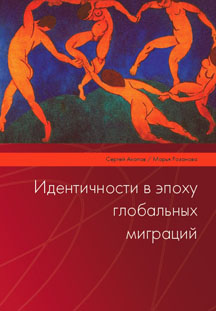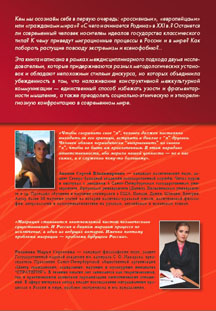
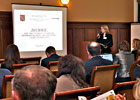 |
|---|
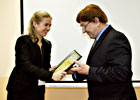 |
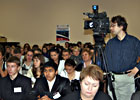 |
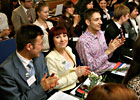 |
| photogallery >> |
|
IDENTITES IN THE ERA OF GLOBAL MIGRATIONS AUTHORS: Sergey Akopov, Marya Rozanova Akopov, Sergey V., Rozanova, Marya S., Identities in the Era of Global Migrations, St.Petersburg, 2010. Pp. 272.
(in Russian) SUMMARY
In search off ways to make human identity more flexible and less liable to phobias, including xenophobia we try to escape “the measles of nationalism”. In this context the key characteristics of the new type of personality can be described in terms of 1) “transnationalism” - a social belonging of individuals and groups not to primarily one particular place (state) but to several, and 2) “cultural creolization” – mutual influence between two or several groups, creating an ongoing dynamic interchange of symbols and practices. It is extremely important to understand that it’s not that the “enemy” images haven’t been completely abandoned in the world “yet”. They are actually deeply rooted in human nature. Therefore in order to override the fear of “the other” inside “us” it is necessary to promote the following: a. increased geographical mobility of population; b. intensive cultural and scientific exchanges and promotion of inter group fertilization; c. the development of transnational Internet networks and communities; d. wider introduction of different foreign languages and other cultural practices; e. intermarriages and cross-cultural children awareness and upbringing; f. further research and promotion of the (meta)narratives of belonging to transnational, shared identities and feelings of solidarity of a global type; g. further support and protection of public intellectuals with “split” political identities, promotion of their role in formation of “friend” images while describing the other cultures. We also try to go “beyond the identity” and answer the question what can unite people beyond their nations and ethnic groups. Thus we analyze the concepts of “cosmopolitan patriotism”, “cultural dialogue”, “political friendship” and to what extent they might be considered as common grounds for people’s solidarity in the 21st century. After theoretical discussions we turn to practice and devote second part of this book to the analysis of the contemporary migration processes, particularly in Russia. We investigate the historical roots of the clash of ethno-religious and cultural identities. We focus on analysis of the models of interaction with migrants, as well as the new migration policies, and recommendations on migration policy improvements in Saint Petersburg. The book infers that during the last decades, Russia's identity has transformed and consequently became more fragmental and more national than both the former “imperialist” and the Soviet USSR identities. While some regions after the fall of the USSR remained almost purely monogeneous, others in contrast faced rapidly changing ethnic/cultural diversity and imbalance. These are mostly urban areas (like Moscow and St.Petersburg) that became the magnets for most of immigrants/migrants from the former Soviet republics mainly populated by Muslims. The proliferation of the new “Diasporas” in Russia for the last almost two decades has demonstrated their growing viability and visibility. The influence of these Diasporas on the social and economic life of their host country is growing every day. This cultural and social phenomenon is completely new for Russian society because the characteristics of these Diasporas are national segregation, social and labor isolation, and the lack of social integration into host society. The Russian host community on their part demonstrates high level of intolerance towards not just these groups of newcomers but to any kind of ‘otherness’. All these controversies create unprecedented risks and conflicts under the conditions of strengthening of migratory flows, decline of the density of Russian population and the lack of the real public migration policy. A fragmentation of Russian society occurs as the result of the lack of common political and social values, leading to a revival of racist and nationalistic ideology and the growth of extremist tendencies. The authors of the book particularly outline that new cities being the magnets for immigrants are very diverse, fluid, flexible, changeable and dynamic and this way cannot be totally described in terms of narrow assimilation or multicultural theories. Only the combination of elements of the classical and new models of multiculturalism, the concept of communitarianism, old and new models of assimilation can give the positive result. It is vital to find the best possible complex approach toward the social interconnection harmonization, towards better integration of immigrants into the host society and the negotiation of the identity clashes. |
|
CONTENTS
Introduction Sergey Akopov Part II. Identity and the Emergence of Missionary Zeal Part III. The Formation of the Transnational Community in the Era of Globalization Part IV. The Image of the “Enemy”: Theoretical Approaches to Understanding the Phenomenon Marya Rozanova Part VI. Mechanisms of Inter-Ethnic Relations Harmonization |
||
